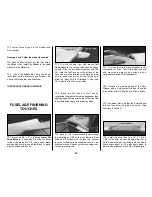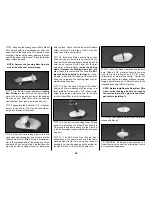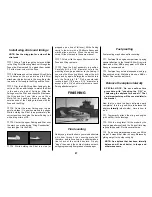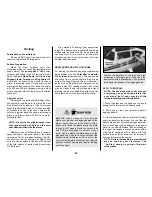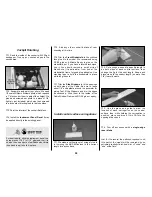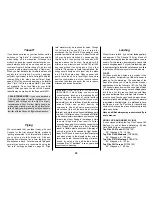
If you have dual rates on your transmitter, set the
switches to "high rate" for takeoff, especially
when taking off in a crosswind. Although this
model has good low-speed characteristics, you
should always build up as much speed as your
runway will permit before lifting off, as this will
give you a safety margin in case of a "flame-out."
When you first advance the throttle the plane will
usually turn left slightly. Correct by applying
sufficient right rudder to hold it straight down the
runway. When the plane has sufficient flying
speed, lift off by smoothly applying up elevator
(don't "jerk" it off into a steep climb!), and climb
out gradually. Do not use flaps for your initial
takeoff. After you have the feel of the Cessna,
takeoffs may be made with the flaps set at 50%.
We recommend that you take it easy with your
Cessna for the first several flights, gradually
"getting acquainted" with this realistic model as
your engine gets fully broken-in. Add and
practice one maneuver at a time, learning how
she behaves in each. For ultra-smooth flying and
normal maneuvers, we recommend using the
"low rate" settings as listed on page 52. "High
rate" elevator may be required for spins. Though
the full scale Cessna 182 is not rated for
aerobatics, the Top Flite 182 is capable of some
graceful aerobatic maneuvers. A beautiful barrel
roll may be accomplished by advancing the
throttle to full, then pulling the nose about 25
degrees above the horizon. Apply about 3/4
aileron in one direction, and let the 182 roll 360
degrees without touching any of the other
controls. If the proper roll rate is established, the
wings should come back to level with the plane
in a 20 to 25 degree dive. Reduce power and
gently raise the nose to level flight. Loops are
easily accomplished, but you should reduce
power as the plane goes over the top to reduce
stresses and enhance realism.
When it's time to land, fly a normal landing pattern
and approach. The Cessna 182 may bleed off
airspeed more rapidly than the sport planes you are
used to. For this reason, be prepared to carry a little
power during approach. For your first landings, plan
to approach slightly faster than stall speed and flare
a few inches off the runway onto the main wheels.
FLAPS
Full flaps make the Skylane very steady in the
landing pattern, but just carry a little extra power to
make up for the extra drag. The extra drag of the
flaps also allows you to make shorter, steeper
approaches. Like the full scale 182, the Top Flite
182 needs to touch down with a nose high attitude
to avoid whacking the nose gear and skipping back
into the air. For this reason, landings with flaps
require a deliberate flare with high rate elevator to
raise the nose. Touch and go's and go-arounds can
be accomplished with full flaps, just use the elevator
to establish a shallow climb. It is preferred to have
the flaps up or at "half" setting for takeoffs and
climb-outs because the plane will accelerate and
climb much better.
Have a ball! But always stay in control and fly in
a safe manner.
GOOD LUCK AND GREAT FLYING!
If you enjoyed building the Top Flite Cessna 182
Skylane, try one of these outstanding .60 size
Gold Edition kits as your next project.
Top Flite AT-6 Texan
(TOPA0130)
69” Wingspan, 7.5 - 10 Lbs.
Top Flite P-40E Warhawk
(TOPA0120)
64” Wingspan, 8 - 10.5 Lbs.
Top Flite P-51D Mustang
(TOPA0110)
65” Wingspan, 8 - 10 Lbs.
Top Flite F4U Corsair
(TOPA0100)
62” Wingspan, 7 - 9.5 Lbs.
Landing
CAUTION
(THIS APPLIES TO ALL R/C
AIRPLANES): If, while flying, you notice any
unusual sounds, (such as a low-pitched "buzz")
this may be an indication of control surface
"flutter." Any time you detect flutter you must
immediately cut the throttle and land the airplane
because flutter can quickly destroy its
components. Check all servo grommets for
deterioration (this will indicate which surface
fluttered), and make sure all pushrod linkages are
slop-free. If it fluttered once, it probably will flutter
again under similar circumstances unless you can
eliminate the slop or flexing in the linkages. Here
are some things which can result in flutter:
Excessive hinge gap; Not mounting control horns
solidly; Sloppy fit of clevis pin in horn; Elasticity
present in flexible plastic pushrods; Side-play of
pushrod in guide tube caused by tight bends;
Sloppy fit of Z-bend in servo arm; Insufficient glue
used when gluing in the elevator joiner wire or
aileron torque rod; Excessive flexing of aileron,
caused by using a too-soft balsa aileron;
Excessive "play" or "backlash" in servo gears; and
Insecure servo mounting.
Flying
1.20 4-STROKE NOTE:
If you have installed a
1.20 4-stroke engine, throttle management on
takeoff and throughout the flight is highly
recommended! Your first few flights should be
made using slightly more than half throttle for
takeoff. Apply power gradually until you become
familiar with the Cessna’s flight characteristics.
Takeoff
55
Summary of Contents for CESSNA 182 SKYLANE
Page 8: ...8 DIE CUT PATTERNS ...



